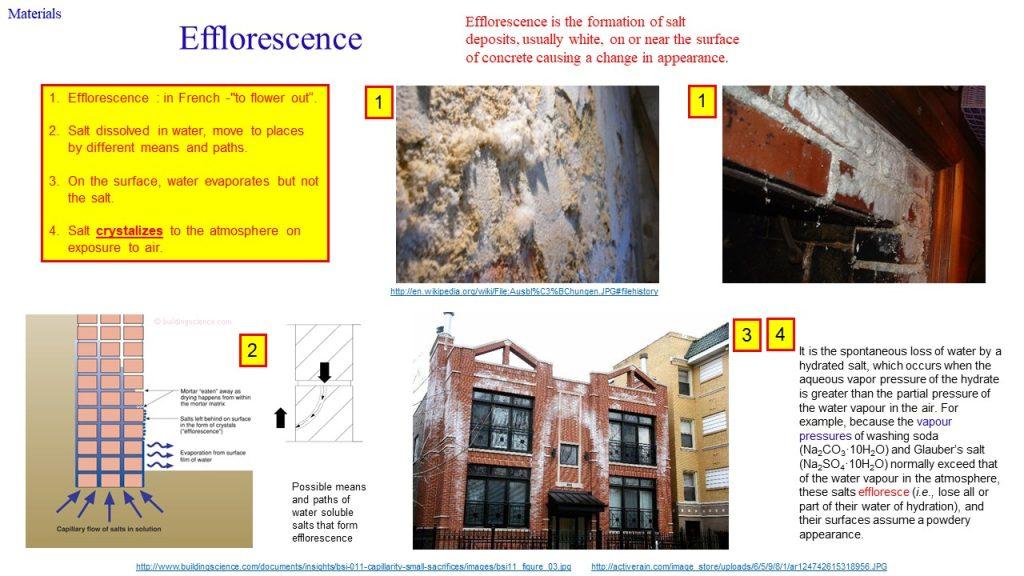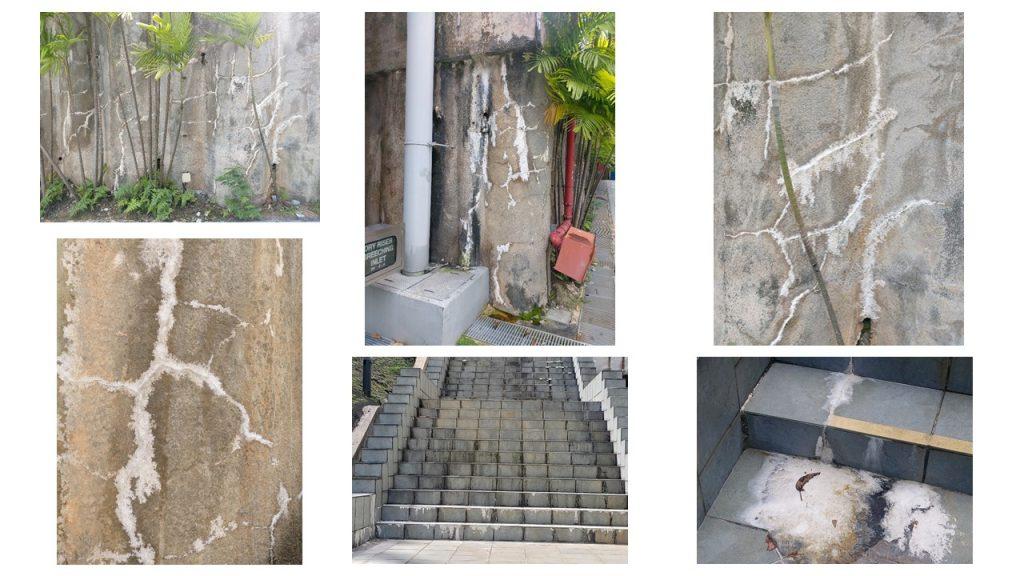Efflorescence
Efflorescence is the formation of salt deposits, usually white, on or near the surface of concrete causing a change in appearance.
It is the spontaneous loss of water by a hydrated salt, which occurs when the aqueous vapor pressure of the hydrate is greater than the partial pressure of the water vapour in the air. For example, because the vapour pressures of washing soda (Na2CO3·10H2O) and Glauber’s salt (Na2SO4·10H2O) normally exceed that of the water vapour in the atmosphere, these salts effloresce (i.e., lose all or part of their water of hydration), and their surfaces assume a powdery appearance.


Good Practices
Design
Specify material and application methods for water repellence of porous masonry in accordance with BS 8221-2, SS 509-2 or equivalent. Throw off water from the façade altogether through an outward projecting sill or overhanging eaves (which incorporate a throat or drip lines on its underside) or provide blocking features such as copings/flashings. Use efficient scupper drains/downpipes to channel water down and away from the façade. To provide drip grooves along the underside of projecting features. Specify a paint system, which is permeable to avoid any paint defects which may cause staining.
Render the detailing for open joints as opposed to butt joints to avoid sealant staining. To use nonbleed sealants so as to prevent staining from silicone oil. Recommend joint designs, which are able to retain runoff within joints and expansion joints designated to provide vertical runoff carrying dirt down along the façade surface. Specify façade selfcleaning applications (e.g., TiO2, superhydrophobic paint products, etc.) with due consideration given to site orientation, sunshades and protruding features. To understand the impacts of environmental, material, design and maintenance aspects on rainwater runoff; see “Staining of Facades”.
Construction
Paint façade surfaces evenly with no patchiness. The finished texture should be uniform in colour. Ensure proper rendering to control surface granularity and local faults as it influences colour uniformity of the external façade in accordance with ISO 7361 or equivalent. Correct sealant applications to ensure consistent and continuous quality. Avoid misaligned panels of cladding in accordance with BS 8000-0 or equivalent. Refer to the planning of the painting programme, including inspection regime (initial and routine inspections) for buildings in accordance with BS 6150, SS 542 or equivalent.
Use self-cleaning coatings on newly built substrates for increased success in its performance. All construction/repair works on a façade surface should be done prior to application of a water repellent in accordance with BS 8221-2, SS 509-2 or equivalent. For serviceability of exterior façade surfaces, adopt ASTM E1667-95a or equivalent. It is important as it dictates the building’s individual and corporate identity. The correct application of TiO2 coating is crucial to ensure proper adhesion to the substrate. It is also challenging to check the proper application of the coating, especially on high-rise buildings, due to
its transparent property.
Maintenance
Consider availability of adequate water supply, drainage provisions and electrical power supply to choose a façade cleaning method. Records of cleaning operations (including photographs before and after cleaning, and drawings of nature of deposits, thickness and patterns) should be kept for buildings of significance in accordance with BS 8221-1, SS 509-1 or equivalent. Maintain the façade in a state as near as possible to its new condition. Ease of façade maintenance can be expressed by the frequency of necessary maintenance operations, labour and supplies necessary for each maintenance operation,
and number of possible ways of removing stains, graffiti, etc., or ISO 7361 or equivalent.
Detect/determine staining of porous substrates by joint sealants (ISO/NP 16938-1). Adopt the recommendations for treatments for controlling organic growth in accordance with BS 8221-2, SS509-2 or equivalent. Repair painted surfaces damaged by wear and tear; wash down; remove defective paint film; apply sealer/primer (if necessary); and repaint in accordance with BS 6150, SS 542 or equivalent. TiO2 only works where there is sunlight. Conventional cleanings are still needed for non-coated areas. For areas coated with TiO2, conduct neutral cleaning annually.
Diagnostics of Defect (see also NDT)
Finding the source of water ingress into the facade system is most crucial. The following methods are recommended:
Thermography can be used to identify the position of cracks. A range of crack widths, representing mechanical damage, has been induced under controlled laboratory conditions. The method is based on the characteristics of heat flow phenomenon, in a conductive medium of specific geometry, which is intended to model predetermined boundary conditions.

Microwave tomography is a technique to measure the moisture of various materials based on the relatively high dielectric constant of “water” in comparison to the dielectric properties of the material. An electrical field (microwave) is applied to the material, and the microwave induces oscillations of bipolar molecules (i.e., water). Water molecules will reflect and absorb an electrical field during oscillations. A higher electrical field reflected indicates higher water content.
The technique is non-destructive and applicable to wood, brickwork and concrete. The uniqueness of this technique is its ability to measure moisture content at various depths up to 110 mm, allowing the plotting of a 3-D contour of moisture content and facilitating the tracing of the water source.

Remedial (see also Remedial)
Find the source of water ingress, stop further water ingress using methods such as sealing, injection, impregnation (see Remedial).
Removal of Efflorescence
-If efflorescence exists on an existing surface, the best method of cleaning or removing it, would be to use an acidic cleaner. These salts and minerals would readily dissolved in these acidic cleaning agents.
-Care should be taken when using these acidic agents which may be corrosive in nature.
-Occasionally, the cleaning and removal process can become more difficult if latex or chemical transmission occurs at the same time as the salts and minerals surfaced. These latex or comparable chemicals are often found in the more recent and advanced cementitious adhesives and grouts available and can form a protective layer which defends the efflorescence from direct contact with acidic cleaning products.
-To help solve this problem, select an acidic product that has cleaning agents in it (acid and cleaner in one single product). Another recommendation would be to use a high alkaline restoration cleaner to break down the latex protective coating, rinse well and then proceed with the acidic cleaning.
Repair: Application of Water Repeller
This type of solution act as a hydrophobic surface by penetrating into the pores of the bedding or screed layers and tightening the pores such that the water is not allowed to penetrate through.
It allows vapour to escape and prevent any development of hydraulic pressure caused by the retained moisture.
Repair: Application of Water Proofer (Silicate based)
This kind of solution reacts with the free lime in cementitious materials and seals the pores and cracks in the surface. In fact, as long as moisture and free alkali is present, the reaction will continue by sealing pores. This can also be referred to as “active” repair.
Repair: Application Water-based Clear Coating (with polymer particles)
In this treatment the floor is ponded with the solution and allow the super fine polymer particles to penetrate into the porous structure to form a permanent and continuous plug.